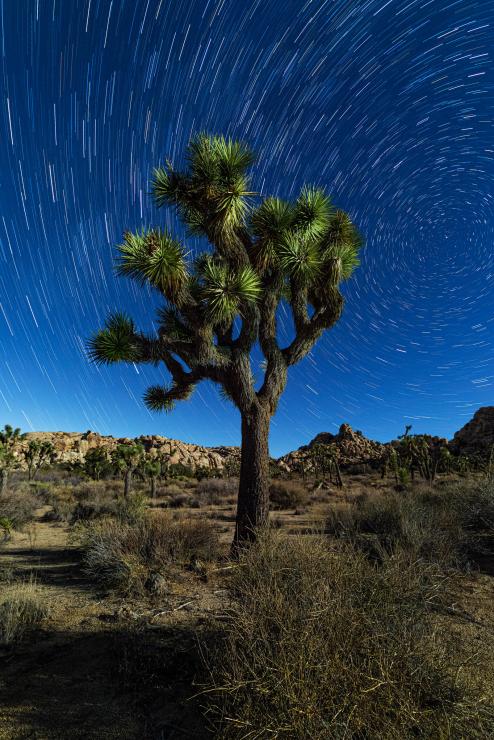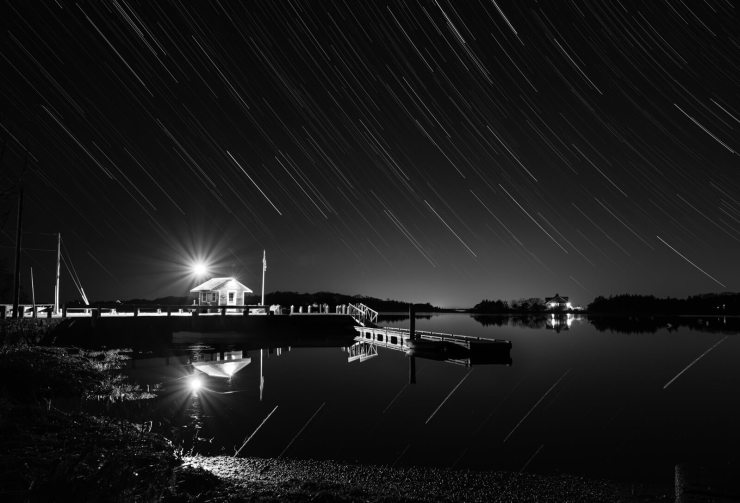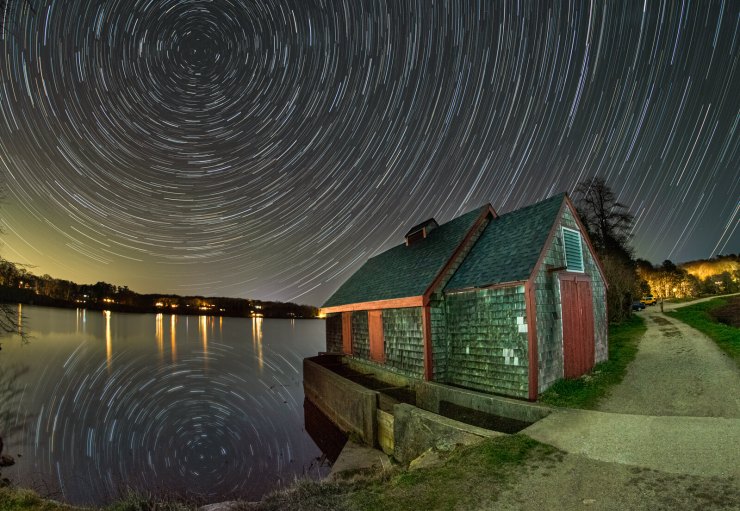Many night photographers prefer to create star trails by taking shorter individual photos and combining them to create a longer blended image.
There are benefits to this. For instance, you can use Layer Masking to remove unwanted light if someone walks past with a flashlight or headlights. This would otherwise completely ruin a longer single exposure. Also, the act of stacking to create a blend also reduces the noise in the photo.
This, however, typically requires some post-processing. While it’s not actually all that difficult with free apps like StarStax, Pentax K-1 users have the ability to do this easily in-camera and have a completely finished star trails image.
Tim Little is a Cape Cod-based night photographer. He created this short five-minute video that is a perfect companion to this article.
I also was able to ask Tim some more about how he does this … and why.
What are some of the advantages of using the internal intervalometer of the Pentax K-1 to create star trails?
“You do not need to carry an additional accessory such as a shutter release cable or intervalometer, whether wired or wireless. I find that the biggest failure point for most folks when it comes to accessories is the intervalometer. The reasons can range from worn-out equipment, dead batteries, receivers that don’t pair properly and so on. At almost every event I host, there’s at least one person who can’t get their accessories to work properly. It’s a quick way to take the wind out of someone’s creative sails.
“With some basic understanding of the Pentax system, you can set this up in-camera and let it go. After years of using cables, it almost feels like cheating. Not only can you do this to create in-camera star trails, you could use this functionality to gather images for stacked astro exposures (see my article for more about stacking images for Milky Way skies) or for processing star trails at a computer later. This simple feature gives you a lot of flexibility.”

Is making star trails in the Pentax K-1 easy to do?
“It’s actually pretty simple. If you choose to do it in-body, the camera essentially outputs a completed image at the end of the run.”
Is it easy to use the intervalometer?
“It sure is. Once the exposure settings are dialed in, it’s just a matter of calculating how many shots are needed to get the desired composite time. For example, I did a star trail composite last year consisting of ninety images, each one lasting 30 seconds, which gave me 45 minutes of star trails.”
Why is it best to set the Standby Interval to “minimum”?
“Any time you do multi-shot composites for star trailing you will natively get some very tiny gaps between the shots creating what may look like segmented star trails. Pixel-peepers may notice this, especially on the longer trails in the shot.
“You should use the shortest possible amount of time between shots to help minimize this. If you wait too long, the segmentation may become more obvious as the sky moves. There is some software out there that can assist with this if stacked on a computer with features such as ‘gap filler’ but this is not a native option for the Pentax in-body stacking.”

What is the longest exposure I can create with the internal intervalometer?
“Here’s the rub: The intervalometer function is available in Manual ,ode but not in Bulb mode at this time. What this means is that exposures are limited to the standard 30 seconds. This may be OK in some conditions if it is permissible to widen the aperture and/or increase the ISO because time can no longer be leveraged.
“If you prefer to leverage time and would like to use Bulb mode, you will have to bring your own intervalometer. In that case you’d simply use it to set your time, number of shots (to match whatever you told the Pentax) and time between shots.”
Which Composite Mode would you recommend for star trails? Why?
“Pentax will give you three options: Additive, Bright and Average. I would advise you to use Bright mode. It records the brightest pixels from each successive shot into the final composite.
“Ideally, the camera sensor will record adjacent light pixels as the as the stars move through the sky. The ground will stay at whatever brightness each exposure allows provided no additional light is added in later exposures. It’s actually a really great process!
“Additive appears as though the shot has collected light cumulatively throughout the run time and compounds just like a continuous long exposure would. This may not be an issue in some conditions but in areas with ambient lighting or light pollution, it will become a problem quickly.
“And Average will do exactly what it sounds like. It will average out the exposure. This is not ideal for recording star trails.”

Do you feel it’s a good idea to keep my Save Process checked?
“When it is available, absolutely. This is insurance against anything that may happen outside your control, such as somebody walking through with a flashlight or other distraction. Or in the event something goes haywire with the internal compositing. With the saved images, you can easily remove issues or re-composite if you need.
“Also, it gives you material for a time lapse or other creative output. Just remember, it’s a lot of data saved to your card so if you are low on space, not checking that box means you get just the composite.
“However, this option is not available in the Bulb mode function.”
What are typical settings that you might use for photographing star trails in this manner?
“My favorite time to collect star trails is when there’s some moonlight (usually between a half moon and the first or last quarter) as it provides a nice amount of natural illumination and also a good amount of star trails. I also prefer the more blue tones of the sky during this time. As I like to use time to collect light, I will use something like ISO 800, f/8 [and a] 2-minute [exposure].
“You really have a lot of flexibility, though. If depth of field is not an issue, your lens performs well in the corners at wide apertures and/or you are happy with your camera’s ISO performance, you could shorten your time, bump to ISO 1600 and slim down to as short as 30 seconds so you can use the internal intervalometer entirely.”
What should I focus on?
“Shooting at f/8 gives you a little bit more wiggle room when it comes to focusing, especially when shooting wide angle landscapes. I tend not to shoot any foreground subjects that are very close so as to avoid some of the post processing focus challenges that may occur. You can, of course, practice hyperfocal or other techniques. I try to keep things as simple as possible so I may use an actual star or even a distant foreground object I can hit with a flashlight and use Live View to dial in the focus. Either one works quite well in most cases.”
See more of Timothy Little’s photography
Catch up with Timothy Little’s photography and workshops on his Cape Night Photography website.
Tell your story with the second annual Visual Storytelling Conference!
Experience four days of interactive, online training sessions featuring a range of educational content with experienced photographers and content creators. This free event kicks off with a series of technical boot camps to build essential skills, followed by live, online sessions on photography, video, business and social media. Join live from March 10-13, 2022!
